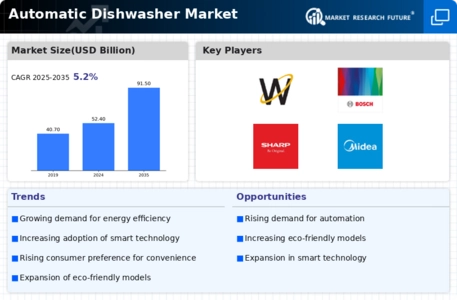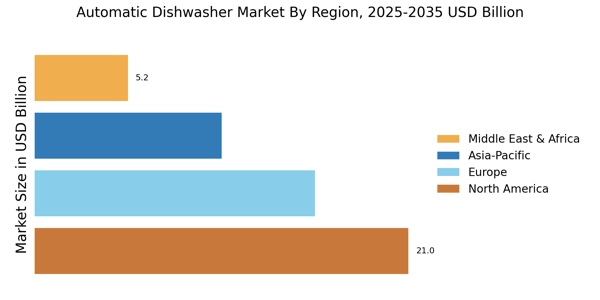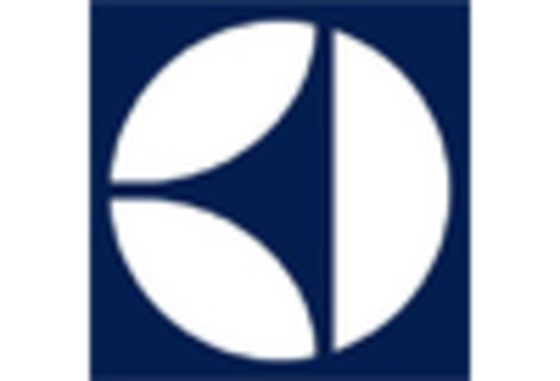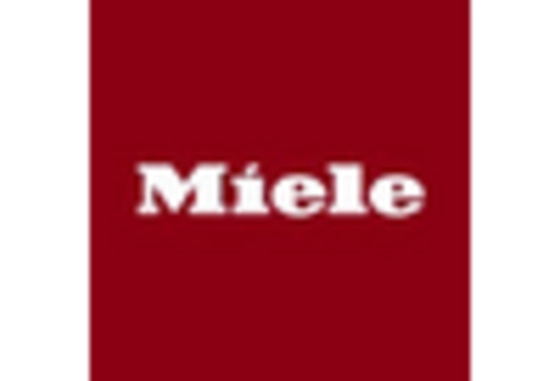Increased Focus on Sustainability
The Automatic Dishwasher Market is witnessing a heightened focus on sustainability, as consumers become more environmentally conscious. This shift is prompting manufacturers to develop eco-friendly dishwashers that utilize less water and energy. Recent statistics indicate that modern dishwashers use approximately 4 gallons of water per cycle, significantly less than hand washing, which can consume up to 27 gallons. As a result, consumers are increasingly inclined to invest in energy-efficient models that contribute to water conservation and lower utility bills. This trend not only reflects changing consumer values but also encourages manufacturers to innovate and promote sustainable practices, thereby enhancing the overall appeal of the Automatic Dishwasher Market.
Urbanization and Space Constraints
Urbanization is a driving force behind the growth of the Automatic Dishwasher Market, particularly in densely populated areas where space is at a premium. As more individuals and families move into urban settings, the demand for compact and multifunctional appliances rises. Automatic dishwashers that fit into smaller kitchens without compromising performance are becoming increasingly popular. This trend is evident in the rising sales of slimline and countertop models, which cater to consumers with limited space. Furthermore, urban dwellers often seek appliances that offer multiple functionalities, such as washing and drying in one unit. This shift towards space-efficient solutions is likely to continue shaping the Automatic Dishwasher Market in the coming years.
Rising Consumer Demand for Convenience
The Automatic Dishwasher Market experiences a notable surge in consumer demand for convenience-driven appliances. As lifestyles become increasingly hectic, consumers seek solutions that save time and effort in household chores. This trend is reflected in the growing sales of automatic dishwashers, which are projected to reach approximately 20 million units annually by 2026. The desire for convenience is particularly pronounced among working professionals and families, who prioritize efficiency in their daily routines. Consequently, manufacturers are responding by innovating features that enhance user experience, such as one-touch controls and quick wash cycles. This shift towards convenience not only drives sales but also encourages the development of more advanced models, further propelling the Automatic Dishwasher Market.
Changing Consumer Lifestyles and Demographics
The Automatic Dishwasher Market is significantly influenced by changing consumer lifestyles and demographics. As younger generations, particularly millennials and Gen Z, enter the housing market, their preferences for modern, efficient appliances are reshaping industry dynamics. These demographics tend to prioritize convenience, technology integration, and sustainability, driving demand for advanced dishwashing solutions. Additionally, the trend of smaller households and single-person living arrangements is contributing to the increased adoption of automatic dishwashers. Market data suggests that households with one or two members are more likely to invest in dishwashers, as they seek to simplify their daily routines. This evolving consumer landscape is likely to propel the Automatic Dishwasher Market forward, as manufacturers adapt to meet the needs of a diverse customer base.
Technological Advancements in Dishwashing Solutions
Technological advancements play a pivotal role in shaping the Automatic Dishwasher Market. Innovations such as smart connectivity, energy-efficient systems, and advanced cleaning technologies are transforming consumer expectations. For instance, the integration of IoT technology allows users to control their dishwashers remotely, enhancing convenience and efficiency. Additionally, energy-efficient models are gaining traction, with many consumers now prioritizing appliances that reduce water and energy consumption. According to recent data, energy-efficient dishwashers can save households up to 3,870 gallons of water annually. This focus on technology not only meets consumer demands but also aligns with broader sustainability goals, thereby driving growth within the Automatic Dishwasher Market.


















Leave a Comment